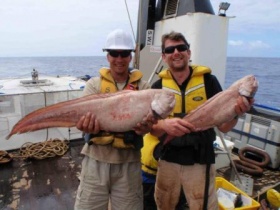Kermadec Trench: The Deep-Water Womble

Ah, I forgot what a joy it is to be on the Kaharoa, a veritable floating bowl of jokes. It is days like today when all the months of preparation and the long hours on deck really pay off.
We brought in all three landers this morning; the abyssal lander from 4000 meters, the fish trap from 4250 meters and the hadal-lander from 4500 meters.
The video footage was fantastic. Lots of macrourids (grenadiers) and ophidiids (cusk eels). The still images from the abyssal lander were rather spectacular too, showing just how abundant fish are at these deep water sites.
However, the big news from today came from the fish trap. So far we have had a few interesting samples from the trap, but today we got some real goodies: two large ophidiids (Spectrunculus cf. crassas), a nice big macrourid (Coryphaenoides armatus) and…believe it or not… a new species of fish!

The new species of zoarcid (Pachycara sp.) from 4250 m. Photo courtesy of NIWA/University of Aberdeen, UK.
The new species of fish is a zoarcid, otherwise known as an eel-pout and this one is of the genus Pachycara. We have photographed them a lot this week and now we have the sample to show that it is new. We are all understandably excited by this find, some more so than others I might add, but what a great result. In fact, the whole 4000-4500 meters site has been a great success.
For anyone who is unfamiliar with zoarcids, they are relatively small, pinky fish that lie on the seafloor, looking somewhat sorry for themselves. They are grazing predators and are likely to be picking off amphipods that engulf the bait. To be honest, they look a lot like wombles (which if you are as unfamiliar with wombles as you are zoarcids, I suggest a quick internet image search).
So, with another few tens of gigabytes of imaging data, a few more fish and a deep-water womble under our belts, we re-deployed all three systems to 5000, 5250 and 5500 meters and spent the rest of the day sitting on deck looking smug and enjoying the sun after a hard days graft.
This article is repurposed from the Scientific American -original post.
About the Author: Dr. Alan Jamieson is a lecturer at the University of Aberdeen, U.K. His research focuses primarily on the use of novel deep-submergence technology for deep-sea biological research, particularly at hadal depths (6,000 to 11,000 meters deep). Dr. Jamieson is the leader of this expedition, which is his tenth one to hadal trenches.







